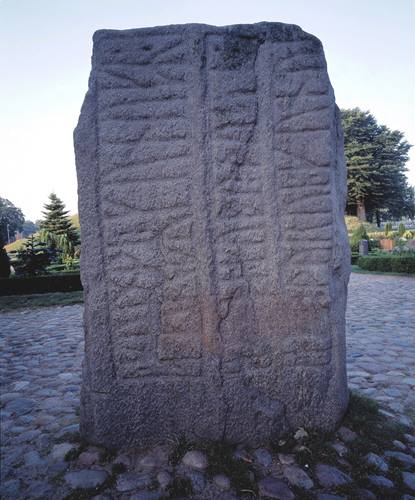History
Denmark is the second oldest monarchy in the world, only surpassed by the Japanese Imperial Court. The first time Danes are mentioned in European history is in the 8th century when Vikings, a common denomination for Scandinavians, became notorious for plundering churches and monasteries along the coasts of the British Isles and Western Europe.
Although descriptions of Danes can be found in many historical works of literature, the state of Denmark only appears in 965, on the so-called Jelling stones, two rune stones with inscriptions stating that King Harold I, also known as Harold “Bluetooth”, unified the country and brought Christianity to Denmark. Denmark was catholic up until the Protestant Reformation in 1536 when Denmark adopted Lutheranism, which has remained until today.
Photo: One of the historic rune stones at Jelling
Throughout history, the size of Denmark has changed dramatically due to wars lost or won. Denmark was the leading power in Northern Europe when the Kalmar Union was established in 1397 under the reign of H. M. Queen Margaret I. The Union combined Denmark, Norway and Sweden along with Greenland, Iceland, the Faroe Islands, the Danish Estonian territories and the duchies of Schleswig, Holstein and Lauenburg into one sovereign kingdom.
The Kalmar Union lasted until 1523 when Sweden gained independence. The 15th century was characterized by intense rivalry between Denmark and Sweden, and after six wars between the two nations, Denmark had lost its Estonian territories and several provinces in Norway. Denmark and the rest of Norway remained united until 1814 when the English bombardment of Copenhagen and the following seizure of the Danish fleet during the Napoleonic wars lead to Norway’s independence. Denmark gained constitutional democracy in 1849.
In 1864 the duchies of Schleswig, Holstein and Lauenburg (now northern Germany) were lost, after a defeat to the Prussian army in the 2nd Schleswig War. The northern part of Schleswig was later given back to Denmark after a plebiscite in 1920. Because of the defeat in 1864, Denmark adopted a policy of neutrality and remained neutral during both World Wars. Nazi Germany occupied Denmark on April 9th 1940, and during the occupation of World War II, Denmark was reduced to its current size in 1944, when Iceland declared its independence. Even though Denmark was officially neutral, it had achieved a de facto recognition as a part of The Allied Forces by the end of the war, due to the activities of the Danish resistance movement. Denmark was hence invited to become a founding member of the UN in 1945.
Denmark joined NATO in 1949 and thus abandoned the policy of neutrality that had been predominant in Danish security policy since 1864. After the war, increasing industrialization sparked a great modernization in Denmark. During the same period, a comprehensive welfare programme was introduced, laying the foundations for the modern Danish welfare state. In 1973, Denmark joined the European Union (EEC at the time).
To read more about Danish history, visit:
https://denmark.dk/people-and-culture/history

